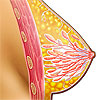Mammograms vital for cancer survivors
Women with a history of breast cancer should be included in population mammography screening programs, according to new evidence published in the latest issue of the Medical Journal of Australia.
“We found that mammography screening through the BreastScreen WA program was associated with a higher detection rate of breast cancer for women with a personal history of breast cancer (PHBC) than for women without [that personal history],” the authors of the study said, highlighting both the capability of mammography to detect breast cancer, and the higher breast cancer risk, in PHBC women.
The study showed that mammography screening detected second breast cancers in breast cancer survivors that were “predominantly smaller than 2 cm and node-negative,” lead author Associate Professor Nehmat Houssami from the University of Sydney and colleagues from BS WA said.
“Our findings support the role of mammography screening for PHBC women, and support allowing these women (in target age groups for screening) to have nationally consistent access to mammography screening through BreastScreen,” Professor Houssami said, although this would require careful monitoring of interval cancers in PHBC women.
The policy on screening breast cancer survivors in Australia is inconsistent, in part due to a lack of data. This study is the first Australian report of screening in these women.
The retrospective study involved more than 700,000 screening mammograms from two groups of women – those who had previously had breast cancer and those who had not – who participated in the BreastScreen WA program in Western Australia between 1997 and 2006. BreastScreen WA has granted breast cancer survivors access to breast screening since its statewide implementation in 1995.
Screening detected 4,125 breast cancers. The cancer detection rate was significantly higher in the breast cancer survivors, at 95.5 per 10,000 screens for all age groups compared with 57.2 per 10,000 screens in women with no history of breast cancer.
“The characteristics of cancers detected in PHBC women were generally consistent with early-detected cancers, and, except for tumour grade, were similarly distributed to those of cancers detected in women without PHBC”, the authors said.
The Medical Journal of Australia is a publication of the Australian Medical Association.
(Source: Australian Medical Association : Medical Journal of Australia)
More information
 | For more information on breast cancer, types of breast cancer and its investigations and treatments, as well as some useful videos, see Breast Cancer. |
Dates
Created by:

 Login
Login














